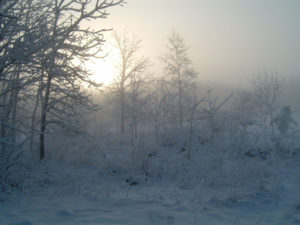Just before Christmas the region was visited by the curious winter phenomenon known as freezing fog.
Freezing fog simultaneously covers the landscape with an ephemeral coating of rime ice while testifying to the curious chemical properties of water.
Fog, like most clouds, is composed of tiny liquid water droplets. In fact, fog is quite literally a cloud that hugs the ground.
Water can remain in the liquid state at temperatures below 32 F (the freezing point), especially if the liquid water particles are small. Such liquid water droplets are known as supercooled water droplets.
Clouds are filled with such supercooled water droplets. In fact, the presence of such droplets in clouds is the reason why aircraft icing occurs because when the droplets make contact with the wing of the plane, the droplets freeze.
When fog develops in environments with temperatures below the freezing point, the fog droplets can be supercooled. When supercooled water droplets make contact with objects whose temperatures are below 32 F, the water freezes.
Thus, as supercooled fog droplets are carried through the atmosphere by the light breezes that accompany fog, they strike tree branches, sidewalks, windshields, etc. and coat these objects with tiny shards of ice.
The longer the freezing fog exists, the more substantial becomes the cloak of ice on the surrounding objects. If you see the sun peeking through the fog while the trees are still coated with the rime ice, you will be treated to a most stunning winter landscape.
If, on the other hand, you are trying to travel, your attention should be directed to the delays that freezing fog is almost certain to compel.
Steve Ackerman and Jonathan Martin, professors in the UW-Madison Department of Atmospheric and Oceanic Sciences, are guests on WHA radio (970 AM) at 11:45 a.m. the last Monday of each month.


